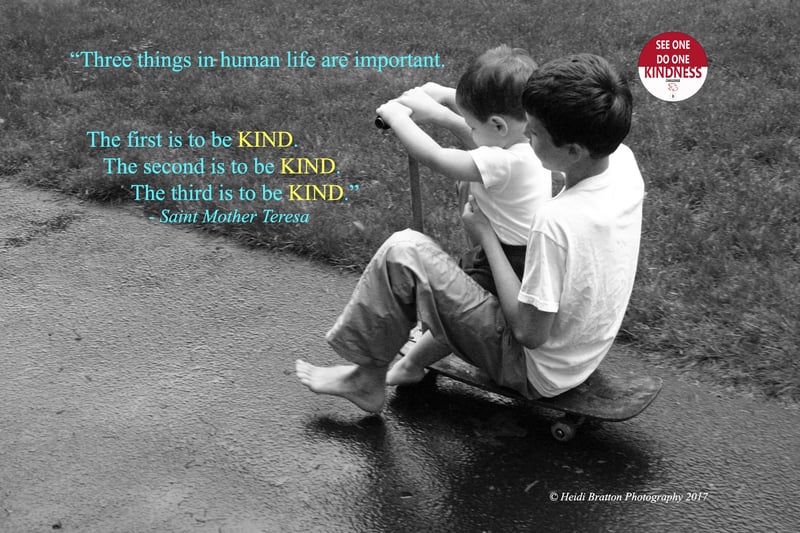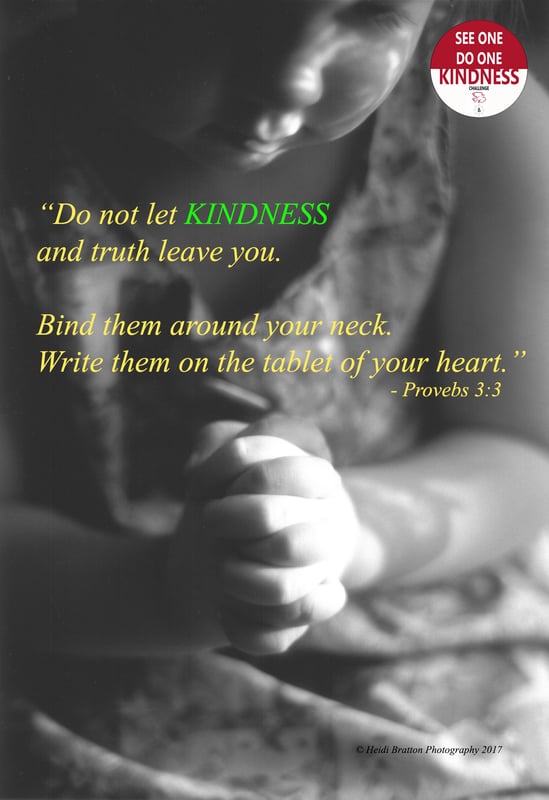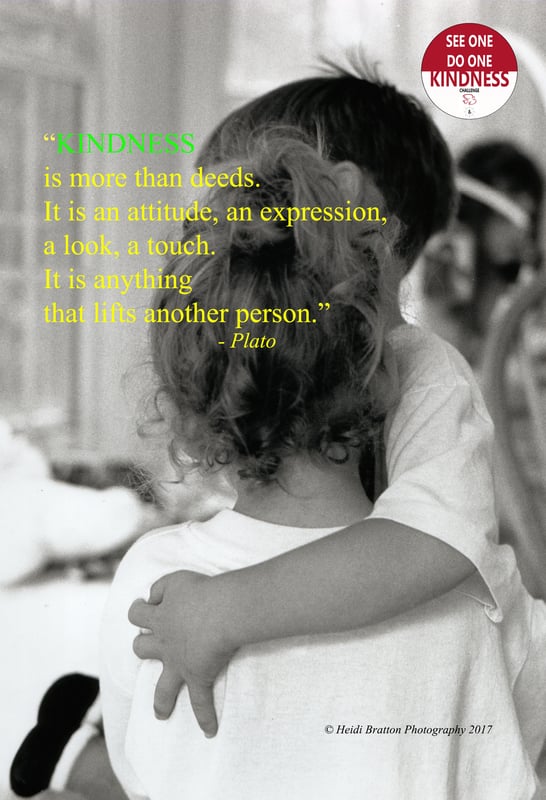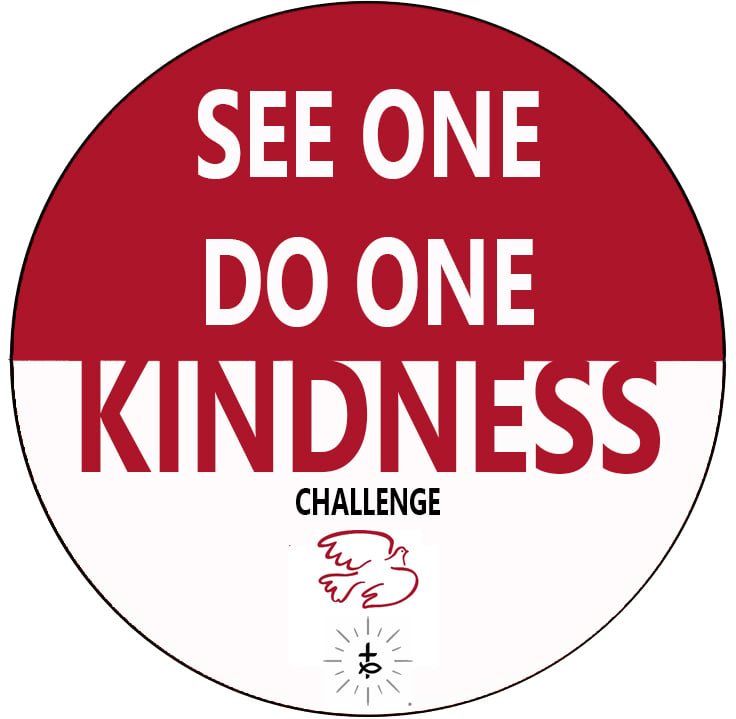Have you ever had the experience of someone’s adding just a little touch of kindness to their voice or to their look at you and its sparking in you an entirely new and better view of life? As if their kindness hooked you up to a big balloon, lifted your spirits above the clatter and clutter which can cloud everyday life and allowed the sun to give you a little kiss on the cheek before setting you down again, wherever you were, but now happier and more full of hope? I have had this wonderful experience, and I’ll bet you have, too. It made me a much, much kinder person nearly immediately, wanting reach out and hook the next person I met to the balloon called kindness, too.
And I am sure you have also had the opposite experience of encountering unkindness that worked on you like a ship’s anchor, yanked you down and moored you to sadness and destress. The speed with which both kindness and unkindness work have always somewhat astounded me.
[tweet "The speed with which both kindness and unkindness work can be astounding."]
Many of the virtues operate like erosion on the relationships to which they are applied. Obedience, patience (of course) and magnanimity, for example, can impact and change a relationship for the better, but only when slowly and surely applied. Kindness, on the other hand, behaves not only like a balloon, but also like an earthquake. It radiates shock waves in every direction travelling straightaway from one person to the next, sometimes permanently altering the course of a person’s day or even their entire life. Kindness begets more kindness.
The need to practice more kindness at home has been on my heart since the beginning of the school year when the principal at the Catholic school where I work introduced kindness as the virtue of the year. She told us that the word kindness had the word “kin” or family as its root, so that the verb, to be kind, really meant to treat everyone as if they were kin. “Very cool,” I thought, “but among my kin might be where I experience kindness the least!” Sad to admit, yes, but I don’t think I am alone in this.
Although written before the year of kindness at my school, one of the meditations in my book, Finding God’s Peace in Everyday Challenges, nails the difficulty and the remedy of being kind to our kin. Where I have used the word “love” in this meditation, substitute the word “kindness” or “being kind” and you will see what I mean:
“Something that is easily forgotten in the rush of everyday life is that peace begins with love. Loving others isn’t only the calling of missionaries in far-off land; loving is the universal Christian call, and peace if one of its fruits. Unfortunately, it has also been rightly observed that it is easier to love the whole world than it is to love the person right in front of us. Why? Because the whole world can’t whine for candy at the store, spill mink on the floor, or take the car without asking (and drive it home with an empty gas tank). It is because the sort of love that Mother Teresa talks about is not an ideal that can be neatly filed away in our heads. Instead, it is like a fire that will not stay confined to our hearts. Mother Teresa treated the poor as people, not as problems to be solved. That was her secret: attending to the one person in front of her and not allowing her love for that person to get hijacked by their problems or the societal problems surrounding them.”
The revamped sentence that still hits home for me is this one: “It is easier to be kind to the whole world than it is to be kind to the person right in front of us.” So very true! I need to do a better job of taking the lofty ideal of kindness in my head and getting it to match the words that come out of my mouth or the work of my hands when I am caught in the rush of everyday life at home.
So what did St. Mother Teresa do differently that made her an internationally known epicenter of love and kindness? She understood that kindness begets more kindness. She operated out of the knowledge that kindness is not only like a balloon, but that it is also like an earthquake. The effect of kindness both lifts people up no matter what is clouding their everyday circumstances and radiates out, surges down the street from one person to the next, touching heart, minds, and hands with warmth and lightness. The uplifting, radiant, and encouraging natures of the virtue of kindness mean we don’t have to marshal a campaign and storm the streets with kindness in order to better the world around ourselves. St. Mother Teresa didn’t encourage anything of the sort. Instead she rhetorically asked and answered, “What can you do to promote world peace? Go home and love (be kind to) your family.” In treating our kin with kindness, those adorable, but pesky ones always crying out for our attention, we act on the belief that the kindness we show in our home will quickly radiate to and surely impact the whole world and that the opposite, unkindness, will do the same.
To really animate the virtue of kindness in each of our students at my school, we have engaged in what we’ve called the “See One, Do One Kindness Challenge,” and I invite you, my fellow Catholic Moms, to join us! The premise of the challenge is simple and is easily duplicated at home. According to the Education in Virtue program created by the religious sisters who run my school, the definition of kindness is “Expressing genuine concern about the well-being of others; anticipating their needs.” After teaching our students this definition of kindness, we challenge them to first become more aware of the kindness of others by having them write down acts of kindness they see others doing (See One). “Look,” we tell them, “for that extra touch of kindness which goes beyond being merely nice or polite and actually shows someone that they are a cherished child of God, that they have worth and dignity.”
After they have seen an act of kindness, we challenge students to use that act of kindness as an inspiration for doing an act of kindness themselves (Do One) and then to also record the act of kindness they do. We set a personal goal for every student to be able to see and do two pairs of kind acts every day; one act seen and one act done at school and one act seen and one act done at home. For my third-grader who attends the school as well as for myself, the act of writing down acts of kindness actually seen and acts actually done has been key to helping this virtue really come alive, rather than remaining a lofty ideal in our heads. As we engage in the See One, Do One Kindness Challenge, I am finding that kindness is becoming more and more second nature with my kin, as well as with my students and fellow teachers, and I think that’s what my sage principal had in mind all along. Kindness done anywhere begets more kindness done everywhere.
So, challenge on, Fellow Catholic Moms! Join me in uplifting and impacting your kin and our world with little touches of kindness and leave comments here on how it’s going.
Find more information about the Education in Virtue program; Heidi’s newest book, Finding God’s Peace in Everyday Challenges, can be found at Amazon.com.
Copyright 2017 Heidi Bratton
About the Author

Guest
We welcome guest contributors who graciously volunteer their writing for our readers. Please support our guest writers by visiting their sites, purchasing their work, and leaving comments to thank them for sharing their gifts here on CatholicMom.com. To inquire about serving as a guest contributor, contact editor@CatholicMom.com.






.png?width=1806&height=731&name=CatholicMom_hcfm_logo1_pos_871c_2728c%20(002).png)
Comments